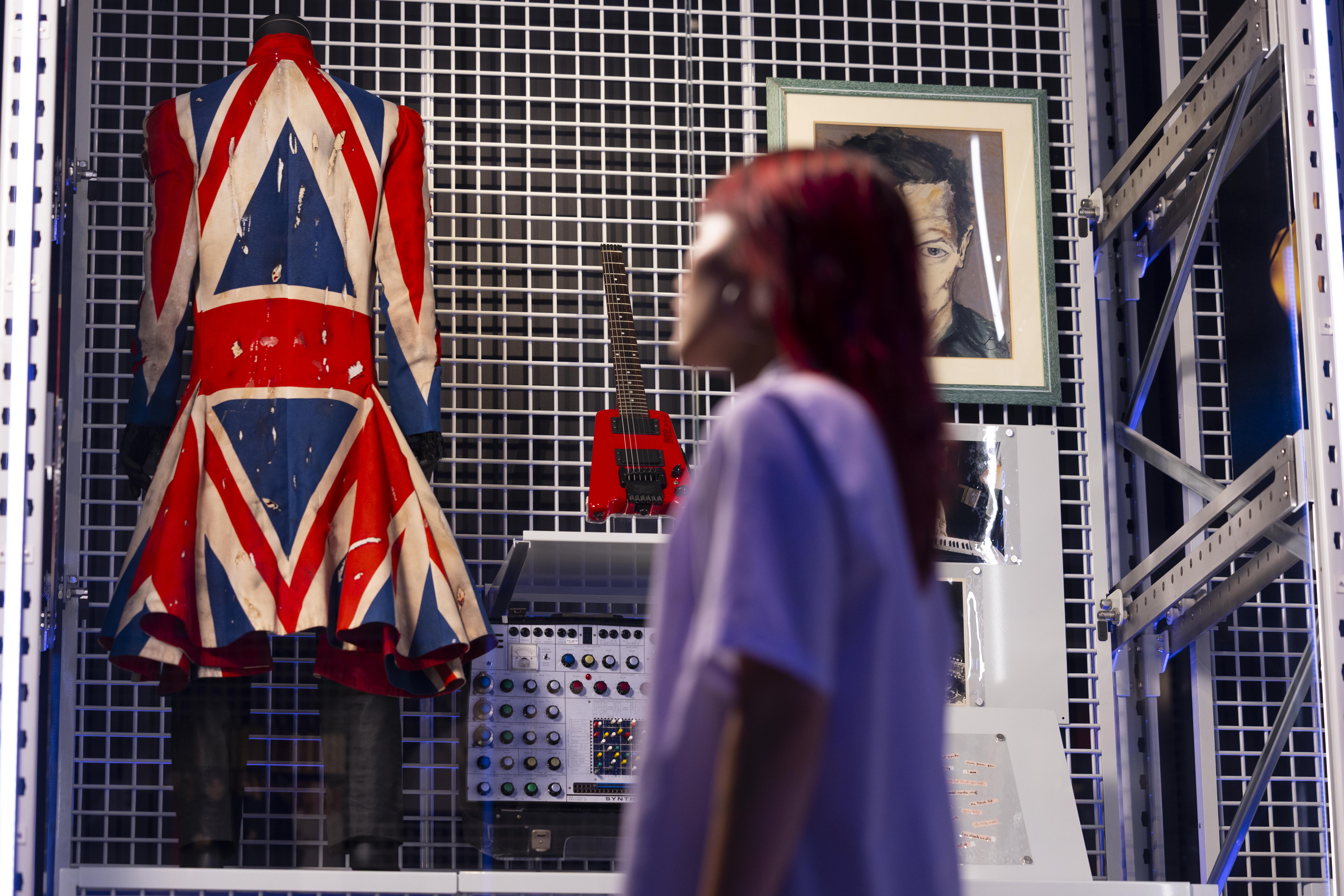It’s not every day that you get to see one of David Bowie’s Ziggy Stardust guitars. Still rarer to see one that has never been put on display before. But that’s exactly what we’re doing at the V&A Storehouse.
The guitar, part of the 90,000-strong collection of Bowie items housed in the warehouse’s vaults, has been whisked up from storage and deposited in the glass-panelled room we’re currently standing in. One string has broken, the case is battered. Clearly, it’s been well-used; one gets the rather haunting impression that it’s just waiting for the singer to pick it up again. Though we’re not allowed to touch it (the curator handles the case with carefully gloved hands), leaning in close to examine the battered varnish still elicits a thrill.
Treasures abound. Next to it, on a separate table, lies one of the singer’s Ziggy kimonos: bright yellow, embroidered with bats. There’s a stain of some kind on the sleeve — possibly food, or make-up, curator Harriet Reed tells us. It feels like a once-in-a-lifetime experience, but good news: the public can see these items, and pretty much anything else in their archives, any time they want.
Ziggy and an unfinished musical

The Storehouse opened in May this year, to rapturous praise from critics. Operating as a storage warehouse for the V&A Museum’s gigantic collection, it’s unique in that it also welcomes visitors. People can come and browse the shelves, or they can select up to five items from the museum’s collection, which will be brought to them during a specific timeslot for their perusal. That includes Bowie’s possessions too. When the musician died in 2016, he left behind a wealth of items collected over the course of a multi-decade career. High-heeled shoes from his favourite New York brand, Pelican. An artist’s palette, still crusted with dried paints. His iconic Ziggy Stardust outfits. A Gitanes cigarette packet from his Isolar tour in 1976.
Bowie, it turns out, was something of a meticulous cataloguer of his own. He hired an archivist and team of his own, and struck up a relationship with the V&A after its 2013 exhibition of his work. After his death, he left behind a mountain of well-maintained items that eventually found their way to the museum. Now, following a painstaking, multi-year project, they’re finally ready to be given to the public.
Yes, that means his suit from the Life on Mars video — which came with a secret second waistcoat that Bowie never wore. But also his to-do lists, his notebooks, his paintings and his picture collection. Heading into the Bowie Centre is a fascinating experience. It’s a roomy space, flanked on either side with examination rooms. The first thing that catches the eye is a huge list of
Heading into the Bowie Centre is a fascinating experience. It’s a roomy space, flanked on either side with examination rooms. The first thing that catches the eye is a huge list of albums and books that lines one wall, all from artists that have been inspired by Bowie over the years. Chappell Roan’s album is there, as is Charli xcx’s brat — a sign that the singer’s legacy still stretches into the present day. Further in, the team have curated a selection of some of Bowie’s most iconic pieces, which form a small exhibition. This will change as time rolls on. They’re also grouped according to theme: we see pieces that pay homage to the singer’s creative processes, including doodled-on set lists and the score for his 1975 song Fame, his love of London’s jungle and drum’n’bass scene and his unfinished projects.

Those post-it notes on his unfinished musical are there, too: hidden away in his locked office, they comprise some initial thoughts for a show called The Spectator, set in 18th-century London and telling the story of real-life petty thief Jack Sheppard. Nobody knew he was working on it until his team found the notes after Bowie’s death. Looking at them, scrawled in Bowie’s messy handwriting, is an oddly poignant experience.
There’s more. The glass globe from his iconic performance in 1986 film Labyrinth; a selfportrait from 2002. Bowie was also a collector of his own fan art, it seems — items on display include a model of him with pipe-cleaner hair, and a David Bowie “rock concert” made from tiny pebbles with googly eyes glued on.
Expenses? Hunky Dory
Bowie’s own meticulous personality is obvious. In one document we’re shown, we see a list of household expenses for a massive recording session that took place at London’s Haddon Hall in 1971 for album Hunky Dory; the top of the sheet bears a post-it note in Bowie’s handwriting telling his team to file it under “Household expenses”.
An unkind person would call him a hoarder; but thank goodness for it. What a treat it is to get to browse this treasure trove: with 90,000 items at our fingertips, imagine what wonders await.







